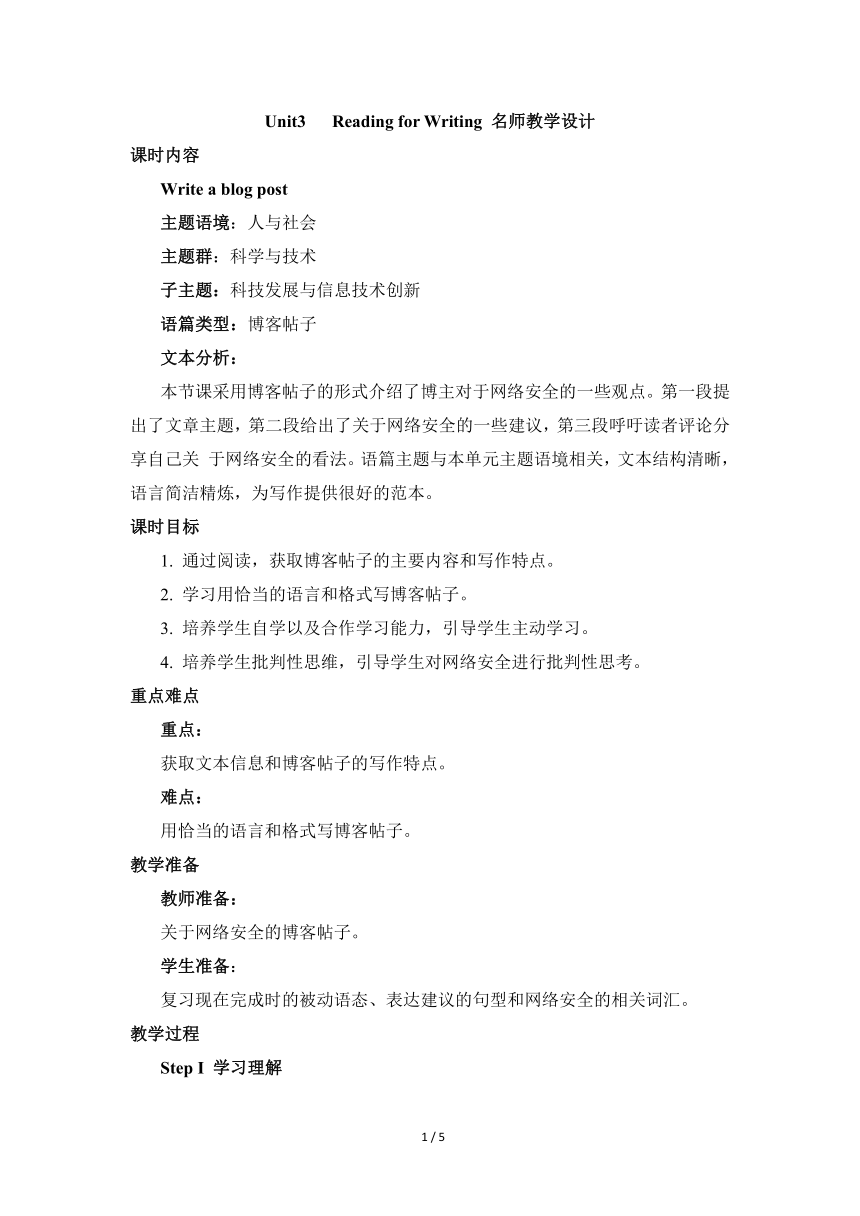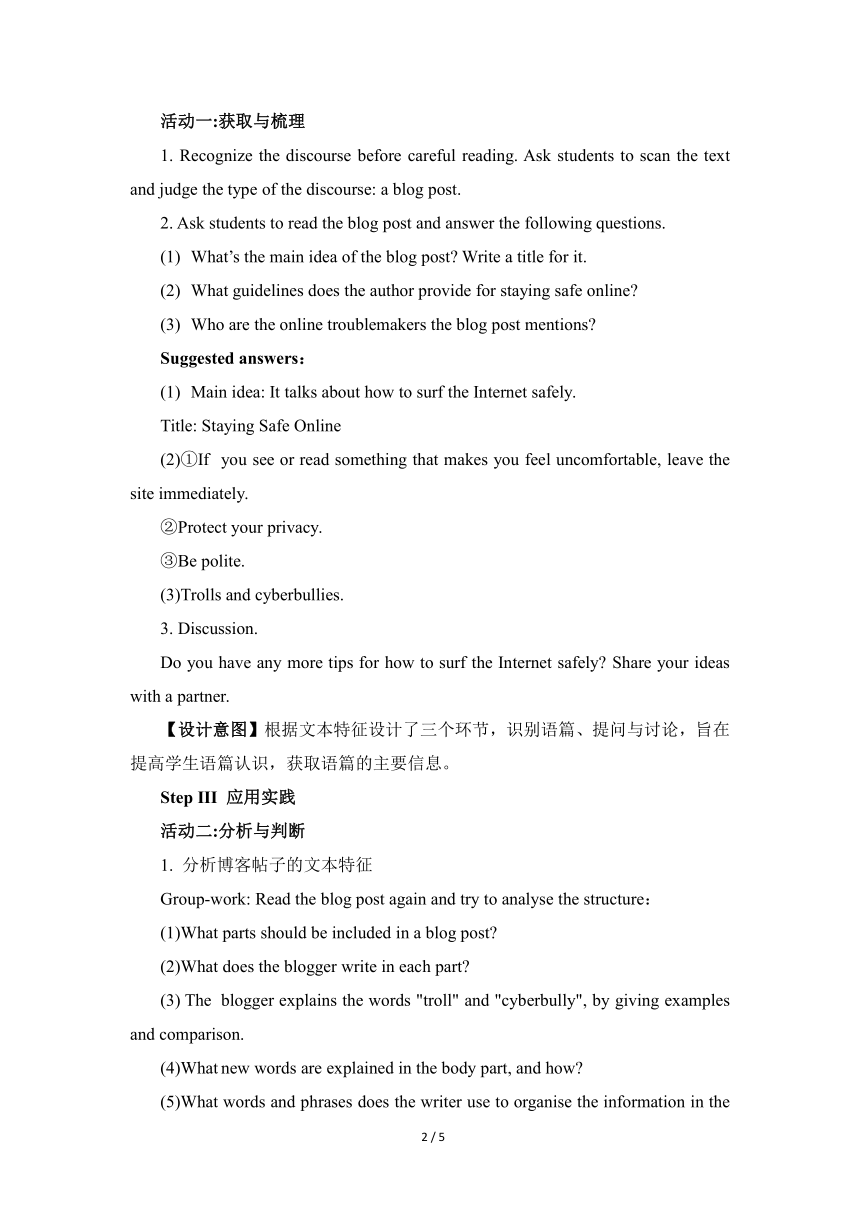人教版(2019)必修第二册 Unit3 The internet Reading for Writing_名师教学设计
文档属性
| 名称 | 人教版(2019)必修第二册 Unit3 The internet Reading for Writing_名师教学设计 |

|
|
| 格式 | doc | ||
| 文件大小 | 32.6KB | ||
| 资源类型 | 教案 | ||
| 版本资源 | 人教版(2019) | ||
| 科目 | 英语 | ||
| 更新时间 | 2023-03-09 21:47:25 | ||
图片预览


文档简介
Unit3 Reading for Writing 名师教学设计
课时内容
Write a blog post
主题语境:人与社会
主题群:科学与技术
子主题:科技发展与信息技术创新
语篇类型:博客帖子
文本分析:
本节课采用博客帖子的形式介绍了博主对于网络安全的一些观点。第一段提出了文章主题,第二段给出了关于网络安全的一些建议,第三段呼吁读者评论分享自己关 于网络安全的看法。语篇主题与本单元主题语境相关,文本结构清晰,语言简洁精炼,为写作提供很好的范本。
课时目标
1. 通过阅读,获取博客帖子的主要内容和写作特点。
2. 学习用恰当的语言和格式写博客帖子。
3. 培养学生自学以及合作学习能力,引导学生主动学习。
4. 培养学生批判性思维,引导学生对网络安全进行批判性思考。
重点难点
重点:
获取文本信息和博客帖子的写作特点。
难点:
用恰当的语言和格式写博客帖子。
教学准备
教师准备:
关于网络安全的博客帖子。
学生准备:
复习现在完成时的被动语态、表达建议的句型和网络安全的相关词汇。
教学过程
Step I 学习理解
活动一:获取与梳理
1. Recognize the discourse before careful reading. Ask students to scan the text and judge the type of the discourse: a blog post.
2. Ask students to read the blog post and answer the following questions.
(1) What’s the main idea of the blog post Write a title for it.
(2) What guidelines does the author provide for staying safe online
(3) Who are the online troublemakers the blog post mentions
Suggested answers:
(1) Main idea: It talks about how to surf the Internet safely.
Title: Staying Safe Online
(2)①If you see or read something that makes you feel uncomfortable, leave the site immediately.
②Protect your privacy.
③Be polite.
(3)Trolls and cyberbullies.
3. Discussion.
Do you have any more tips for how to surf the Internet safely Share your ideas with a partner.
【设计意图】根据文本特征设计了三个环节,识别语篇、提问与讨论,旨在提高学生语篇认识,获取语篇的主要信息。
Step III 应用实践
活动二:分析与判断
1. 分析博客帖子的文本特征
Group-work: Read the blog post again and try to analyse the structure:
(1)What parts should be included in a blog post
(2)What does the blogger write in each part
(3) The blogger explains the words "troll" and "cyberbully", by giving examples and comparison.
(4)What new words are explained in the body part, and how
(5)What words and phrases does the writer use to organise the information in the body part
Suggested answers:
(1) Introduction, body and ending.
Introduction: Tell the reader about himself/herself and what he/she knows about the topic.
Body: Tell the reader what they should do or keep in mind and define some new words or key terms.
Ending: End by asking the readers to write comments.
(2) (4)(答案略)
(5)First of all, second, and third.
2. 赏析语言
Write your own sentences according to the examples.
(l)To give an introduction:
Example:
Today I thought I’d blog about a question that has been asked many times—how do you stay safe online and avoid bad experiences on the Internet
Your sentence: __________________________________________________
(2)To identify a new word:
Example:
A troll is a person who posts comments or questions in order to stir up trouble online.
Your sentence: _________________________________________________
【设计意图】活动二通过阅读课文,分析文本特征和赏析语言特征,挖掘主题意义,学习语篇的写作特征,有助于提高学生对博客帖子写作的认识和理解,为后续写作做了有效铺垫。
活动三:实战演练
1. Compose your blog post.
Choose one of the topics below and use the notes to draft your blog post.
Online shopping sites Social networking apps Online chat rooms
Use a website you are familiar with. Use strong passwords. Don’t use public computers. Don’t post personal information. Don’t believe everything you read. Be polite. Don’t give out too much information. Never meet someone you met online alone.
2. Write your own blog post according to the brainstorm.
【设计意图】本活动为写作实践,学生以小组的形式,根据选择的主题,釆用头脑风暴的形式讨论如何构建博客帖子的介绍、正文及结尾等,降低学生写作难度,增强写作信心。
Step III 迁移创新
活动四:批判与评价
1. Exchange drafts in groups of four and assess each other’s work according to the checklist:
Does the writer tell the reader what he/she knows about the topic
Are the tips and suggestions well organised
Has the writer defined the new words
Does the writer end by asking readers to leave comments and/or suggestions
Can you find any grammar or spelling mistakes
2. Learn from each other.
3. Ask each group to recommend a student’s writing. Choose two of the recommendations to share with the class.
【设计意图】该环节通过小组合作,对组内成员的博客草稿进行综合评价,通过相互学习,加深对主题意义的理解和多元思维的培养,实现深度学习。
板书设计
Unit 3 The Internet
Period V Reading for Writing
I . 学习理解
活动一:获取与梳理
II. 应用实践
活动二:分析与判断
活动三:实战演练
III. 迁移创新
活动四:批判与评价
课时内容
Write a blog post
主题语境:人与社会
主题群:科学与技术
子主题:科技发展与信息技术创新
语篇类型:博客帖子
文本分析:
本节课采用博客帖子的形式介绍了博主对于网络安全的一些观点。第一段提出了文章主题,第二段给出了关于网络安全的一些建议,第三段呼吁读者评论分享自己关 于网络安全的看法。语篇主题与本单元主题语境相关,文本结构清晰,语言简洁精炼,为写作提供很好的范本。
课时目标
1. 通过阅读,获取博客帖子的主要内容和写作特点。
2. 学习用恰当的语言和格式写博客帖子。
3. 培养学生自学以及合作学习能力,引导学生主动学习。
4. 培养学生批判性思维,引导学生对网络安全进行批判性思考。
重点难点
重点:
获取文本信息和博客帖子的写作特点。
难点:
用恰当的语言和格式写博客帖子。
教学准备
教师准备:
关于网络安全的博客帖子。
学生准备:
复习现在完成时的被动语态、表达建议的句型和网络安全的相关词汇。
教学过程
Step I 学习理解
活动一:获取与梳理
1. Recognize the discourse before careful reading. Ask students to scan the text and judge the type of the discourse: a blog post.
2. Ask students to read the blog post and answer the following questions.
(1) What’s the main idea of the blog post Write a title for it.
(2) What guidelines does the author provide for staying safe online
(3) Who are the online troublemakers the blog post mentions
Suggested answers:
(1) Main idea: It talks about how to surf the Internet safely.
Title: Staying Safe Online
(2)①If you see or read something that makes you feel uncomfortable, leave the site immediately.
②Protect your privacy.
③Be polite.
(3)Trolls and cyberbullies.
3. Discussion.
Do you have any more tips for how to surf the Internet safely Share your ideas with a partner.
【设计意图】根据文本特征设计了三个环节,识别语篇、提问与讨论,旨在提高学生语篇认识,获取语篇的主要信息。
Step III 应用实践
活动二:分析与判断
1. 分析博客帖子的文本特征
Group-work: Read the blog post again and try to analyse the structure:
(1)What parts should be included in a blog post
(2)What does the blogger write in each part
(3) The blogger explains the words "troll" and "cyberbully", by giving examples and comparison.
(4)What new words are explained in the body part, and how
(5)What words and phrases does the writer use to organise the information in the body part
Suggested answers:
(1) Introduction, body and ending.
Introduction: Tell the reader about himself/herself and what he/she knows about the topic.
Body: Tell the reader what they should do or keep in mind and define some new words or key terms.
Ending: End by asking the readers to write comments.
(2) (4)(答案略)
(5)First of all, second, and third.
2. 赏析语言
Write your own sentences according to the examples.
(l)To give an introduction:
Example:
Today I thought I’d blog about a question that has been asked many times—how do you stay safe online and avoid bad experiences on the Internet
Your sentence: __________________________________________________
(2)To identify a new word:
Example:
A troll is a person who posts comments or questions in order to stir up trouble online.
Your sentence: _________________________________________________
【设计意图】活动二通过阅读课文,分析文本特征和赏析语言特征,挖掘主题意义,学习语篇的写作特征,有助于提高学生对博客帖子写作的认识和理解,为后续写作做了有效铺垫。
活动三:实战演练
1. Compose your blog post.
Choose one of the topics below and use the notes to draft your blog post.
Online shopping sites Social networking apps Online chat rooms
Use a website you are familiar with. Use strong passwords. Don’t use public computers. Don’t post personal information. Don’t believe everything you read. Be polite. Don’t give out too much information. Never meet someone you met online alone.
2. Write your own blog post according to the brainstorm.
【设计意图】本活动为写作实践,学生以小组的形式,根据选择的主题,釆用头脑风暴的形式讨论如何构建博客帖子的介绍、正文及结尾等,降低学生写作难度,增强写作信心。
Step III 迁移创新
活动四:批判与评价
1. Exchange drafts in groups of four and assess each other’s work according to the checklist:
Does the writer tell the reader what he/she knows about the topic
Are the tips and suggestions well organised
Has the writer defined the new words
Does the writer end by asking readers to leave comments and/or suggestions
Can you find any grammar or spelling mistakes
2. Learn from each other.
3. Ask each group to recommend a student’s writing. Choose two of the recommendations to share with the class.
【设计意图】该环节通过小组合作,对组内成员的博客草稿进行综合评价,通过相互学习,加深对主题意义的理解和多元思维的培养,实现深度学习。
板书设计
Unit 3 The Internet
Period V Reading for Writing
I . 学习理解
活动一:获取与梳理
II. 应用实践
活动二:分析与判断
活动三:实战演练
III. 迁移创新
活动四:批判与评价
